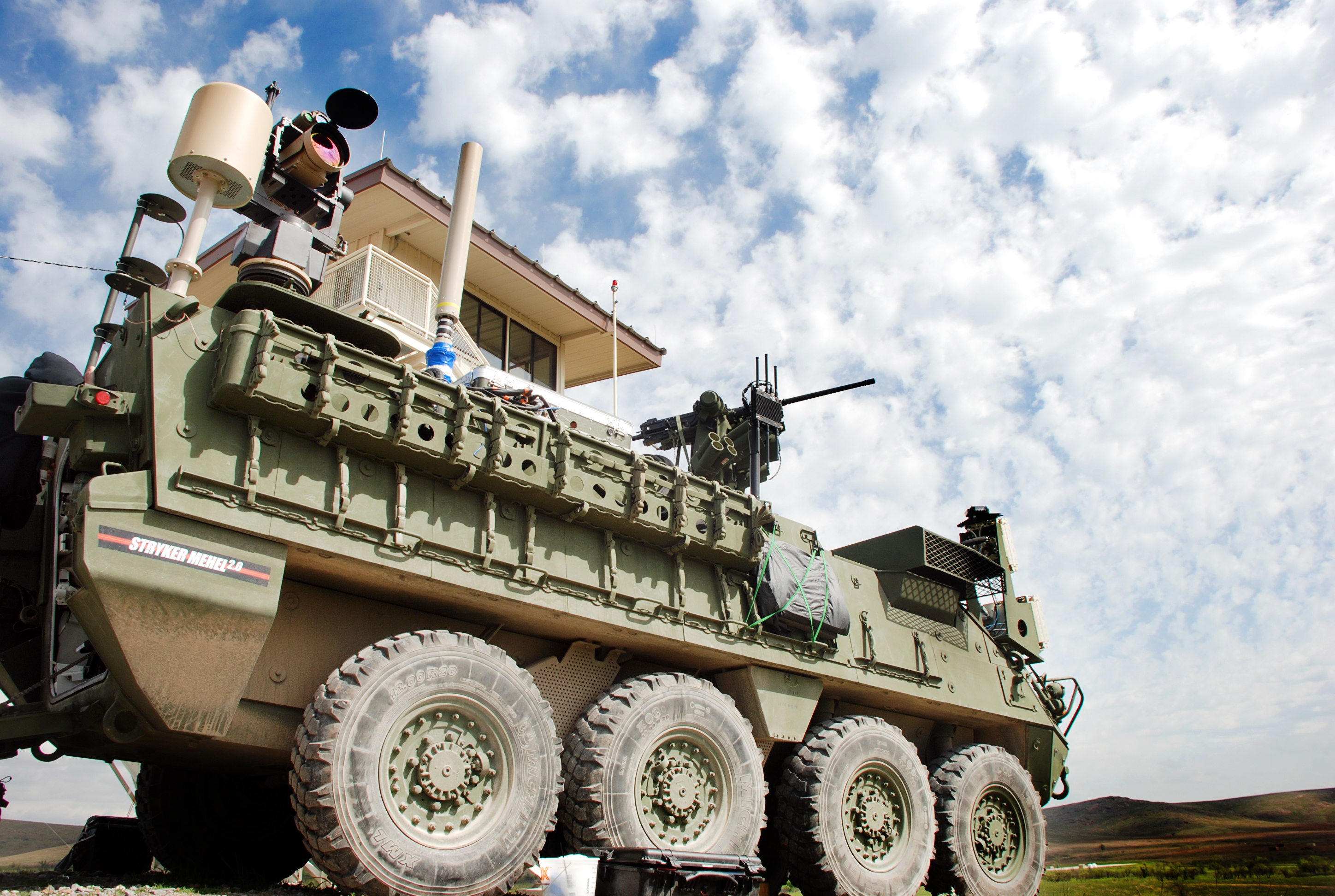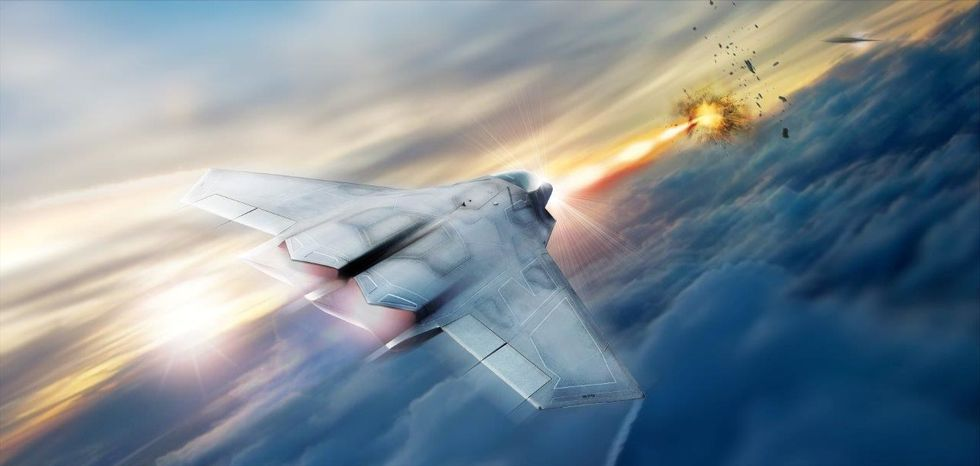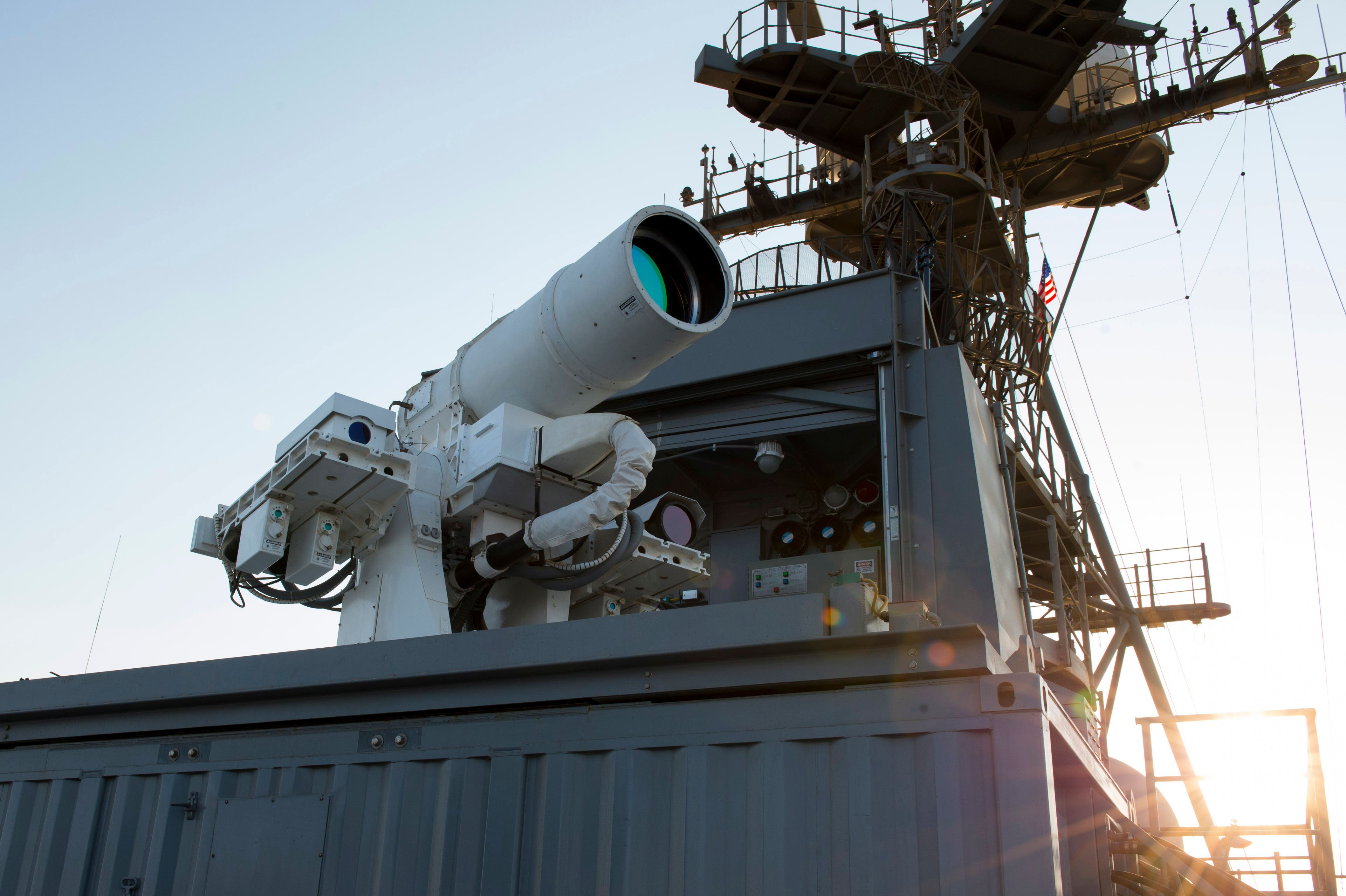The Laser Weapon Is Really, Really Finally Here
Rejoice if you look towards the dystopia of the Star Wars universe, for laser weapons have finally, at long last, arrived. The laser, a weapon system perpetually "ten or fifteen years away" from operational use, is off the development treadmill and entering the field. In addition to the smug banter of science fiction video games, you can now have the weapons too. Here's how they work and how they'll change warfare forever.
A recent article at Aviation Week & Space Technology describes our present day as the dawn of laser weapons, and after a half century of research and development, the Pentagon is finally fielding the first battlefield laser weapons. The Army, Navy, Air Force, and Marine Corps are all looking to field laser weapons on vehicles as diverse as Humvees, guided missile destroyers, and fighter jets.
Lasers are not new to the battlefield entirely. Low-powered lasers have been used since the 1970s to mark targets, providing an invisible-to-the-human-eye aiming point for weapons like the Paveway family of guided bombs and Hellfire anti-tank missiles. Laser are also used to range targets—by shining a laser and calculating how long the beam takes to reach an object, lasers can determine the precise distance between two locations, information that can be used to better a tank gunner's aim, for example.
Lasers as weapons promise considerable versatility—as long as electrical power is available. In the air, lasers could be used against enemy aircraft, missiles, and drones. On the ground, they could be used against personnel, vehicles, and IEDs. At sea, lasers can be used against aerial threats, small boat attacks, and anti-ship missiles. Lasers could even be used by satellites in space, against other satellites or ballistic missiles. Some of these things are harder than others, but it's all theoretically possible.
Most modern weapons use energy in two ways. The first, which you may be mostly familiar with as it's pretty much just how a cannon works, uses energy to propel a projectile towards a target, then to explode the projectile against the target, causing kinetic damage. An anti-aircraft gun, for example, uses the energy created by burning gunpowder to push a projectile out of a barrel, into the sky, and then towards an enemy airplane. Once near the airplane the projectile detonates, the energy from the explosion peppering the target with fast-moving shards of hot metal.
(War is, of course, hell.)

Lasers are fundamentally different. The word "laser" started out an acronym that stands for "Light Amplification by Stimulated Emission of Radiation." Unlike chemical energy weapons, which store and then release energy from gunpowder, rocket propellant and explosives, lasers transport destructive energy in the form of electromagnetic waves directly to the target.
Lasers are, in the simplest sense, highly focused, powerful beams of light. Laser weapons concentrate that light in a narrow beam, which can then be pointed at a target. A laser transfers energy against the surface of the target, energy that manifests as a rapid buildup of heat. A sufficiently powerful beam can cause metals and other solid matter to melt, flammable liquids to ignite, and warheads to explode.
So, to ruin Star Wars a bit further, know in your heart that every time a stormtrooper got hit by Han's laser pistol, he was effectively burning and roasting their insides.
Imagine a laser weapon pointed at an airplane. A laser operator could direct the beam into the cockpit, blinding the pilot and cause him or her to be unable to control the airplane. Alternately, the laser could burn through the skin of the airplane and into a fuel tank, causing a fire. Or, it could burn through the skin of the pilot, killing them. A laser could detonate onboard munitions and their rocket propellant, if any. A laser could even be used to cause structural damage to the airplane, shearing off a wing or stabilizer and causing it to crash.
As you can imagine, the sort of people who spend a long time developing these things also spend a long time imagining how to kill people with these things.

Lasers have several tactical advantages over the standard bullets and bombs. Unlike projectile weapons there is no magazine of bullets or shells that take up volume inside a vehicle. As long as the laser weapon has power, it can theoretically fire an unlimited number of shots. A laser also travels in a straight line, and unlike a projectile is not subject to the effects of wind and gravity. The beam travels at the speed of light, or 186,000 miles per second, and for all intents and purposes cannot be dodged. Once a laser has your number, you're going to have a bad day.
Laser weapons also have disadvantages. Lasers had an exceptionally difficult development curve, requiring decades of research and development before a practical battlefield laser was ready. Lasers require power and lots of it, and a place to store the power before firing. Lasers and their equipment are fairly delicate, and require ruggedization to allow them to survive the rigors of combat.
(I know, I know. "But if a laser is just made of light, can't it be defeated if I hold up a mirror? Reflect it right back at the guy shooting at me, boom, done, I win," you're thinking. Yes, lasers can be technically defeated with mirrors but the mirror surface must be extremely clean and highly reflective to work properly, a tough prospect for machines in wartime.)
Perhaps the laser weapon's biggest flaw is that as it travels through the atmosphere, the concentrated light is scattered and absorbed by dust, water, and other microscopic particles. A laser strong enough to cut a person in half at close range will eventually weaken to the point where it will merely give him a bad sunburn, which is extremely inconvenient and painful, but won't necessarily knock someone out of commission. The problem grows worse as a laser beam passes through a cloud, fog, or smoke. Unlike chemical energy weapons, which release the same amount of energy at the target regardless of distance, a laser weapon grows weaker the farther it travels.
The first deployed laser weapon was the U.S. Navy's AN/SEQ-3 LaWS, or Laser Weapon System. A 30 kilowatt laser system, LaWS was designed to disable drones by torching bits of their bodies off and causing them to become aerodynamically unstable. Alternately LaWs could blind their onboard electro-optical cameras with flashes of intense light. The system cost $40 million to develop and was deployed aboard the floating base USS Ponce in 2014. Although fully operational and combat-ready, LaWS wasn't fired in combat.
Now, just two years later, the armed services are pushing for 300 kilowatt lasers. According to Breaking Defense, the Army, Navy, and Air Force all want a 300 kilowatt laser capable of shooting down cruise missiles. While smaller lasers like LaWS are perfectly good for burning the arms off a quadcopter drone, a cruise missile is basically an low-flying, unmanned jet aircraft traveling at 800 feet per second, giving a defending laser little time to torch it. A more powerful beam can burn targets faster and at greater distances.
Defense against cruise missiles is just the beginning. Lasers shoot down howitzer shells, artillery rockets, and mortar rounds, for the first time providing ground troops protection from enemy artillery. The Air Force wants the the Self-Protect High Energy Laser Demonstrator (SHiELD), a podded laser it can mount on any aircraft, protecting the plane from incoming surface-to-air and air-to-air missiles. And the U.S. Navy wants a laser it can mount on warships to protect against anti-ship cruise missiles.

As lasers gain in power and shrink in volume they'll start to be used offensively. A fighter plane equipped with a weapon that can't be jammed and travels at the speed of the light will dominate the skies. Exactly how a weapon that hits its target, every time, affects the nature of warfare is difficult to predict. Armies, navies, and air forces could be forced into a war of numbers, throwing mass produced weapons at a target defended by lasers until one finally gets through.
At this point the cliche is to say "we are not ready for lasers." In a practical sense, we have been ready for lasers for decades. Laser weapons are late and we have been waiting for them for a long, long time. The armed services are clamoring to stuff them into anything that sails, rolls on the ground or flies.
What we have failed to grasp, even with what is by now nearly a hundred year wait, is how laser weapons will affect human society. The atomic bomb was sprung on the public, out of nowhere, in the closing days of World War II, and not even the physicists and generals understood how it would change the world. Despite the portrayal of laser weapons in thousands of comic books, novels, movies and TV shows, we have only a limited understanding of how they will affect wars and the societies that conduct warfare. The only thing we know for sure is lasers will result in new ways to kill people.
